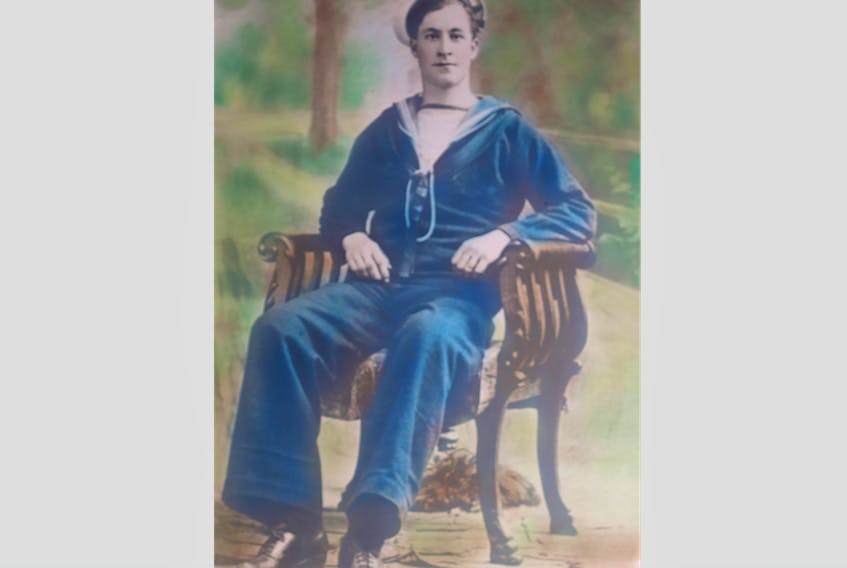When a boy 19 years of age signs his engagement papers with the Naval Reserve, his thoughts are of challenge, excitement, and adventure on the high seas.
He expects to sail to foreign ports and countries that he could only dream about growing up in Hodge's Cove. This sailor was about to witness the worst maritime disaster and resulting carnage to ever occur on Canadian soil – the Halifax Explosion
Harvey Peddle was the son of Abraham and Martha (Smith) Peddle, born at Hodge's Cove on June 28, 1898. His older brother, Caleb, was the first of the family to enlist with the Royal Naval Reserve in 1907. Caleb spent six years training aboard the HMS Calypso but was denied re-enlistment at the beginning of the war because it was determined he was colour blind and could not serve.

Caleb's stories of years in the navy would have encouraged Harvey to enlist with the Royal Naval Reserve. Harvey placed his signature on his application 102 years ago. The date was March 22, 1917. He started training aboard the HMS Briton and completed training in four months.
His first deployment was the Royal Navy Q-ship, Albert H. Whitman, a Grand Bank sailing schooner. The crew sailed the waters around the banks of Newfoundland disguised as a fishing schooner.
Q-ships were various sized ships that were armed decoy ships, made to look like ordinary commercial vessels in hopes of encouraging a German U-boat to surface.
The crew on his ship were dressed like fishermen and there was no indication the schooner was armed. The ship required very brave, patient men ready to jump into action at a moment's notice. It was among one of the most dangerous jobs in the Navy and explains why six Victoria Crosses, the highest gallantry award, were bestowed to crews of Q-ships.
Seaman Peddle's schooner never encountered an enemy U-boat but his ship’s bravery was no less than any other Q-ship in the Royal Navy.
An article that appeared in the Packet entitled Wartime Disaster on Native Soil offers insight into how Seaman Peddle was present for the Halifax explosion. Luke Ivany of Invanhoe explains how he was at sea when they received a message in December 1917 to take his ship into port at Halifax. The ship had been on patrol and naval command had decided it was time for shore leave.
When they arrived in port most of the crew was sent home. Ivany and fellow Newfoundlander Harvey Peddle of Southport were ordered to remain on board to conduct routine maintenance chores.
The next day disaster struck and they witnessed one of the greatest war tragedies ever to occur on Canadian soil, the Halifax Explosion. This event was to have a lasting effect on them for the remainder of their lives. They were horrified by the resulting destruction to buildings that were either blown up or caught fire by the explosion. They saw the resulting human carnage everywhere. People were dead or dying of the injuries sustained by the resulting shock wave in the streets.
Seaman Peddle's account of the devastation has been forever preserved in the form of a letter he wrote home to his mother, Martha. She forwarded the letter for publication to the Evening Telegram on Dec. 20, 1917.
The following are excerpts from his historical letter to a distraught Mom:
"...Well mother. I haven't been in the Navy long but I expect I have seen as big a disaster as ever anybody saw on the other side. Well mother, I thank God that I am alive to-day...."
"...Just at the time of the explosion I was going on deck and I knew nothing before I pitched on the forecastle floor. Ivany (Seaman Luke Ivany, Ivanhoe) jumped out his berth and came on deck to see what happened and I said "For God's sake, if you want to save your life, don't go on deck..."
In a postscript, Seaman Peddle’s strongest words were written: "...While I was handing the men I didn't mind a bit, but when the poor women and children came it was hard you may depend, but I didn't mind a bit."
Surely he meant these words as a means of comforting his distressed mother as she prayed for her son's mental state in times of such devastation.
Seaman Peddle was promoted to able seaman and was assigned to the Royal Canadian Navy at Halifax for the remainder of his naval career abroad. He was assigned to the HMS Niobe, a shore-based facility where he spent the next 15 months.
He returned to the HMS Briton and was received demobilization on April 2, 1919.
He returned to Hodge's Cove and spent some time working in the Boston States. When he returned he married Minnie Pepper the Anglican School teacher at Hodge's Cove. She was the daughter of Isaac and Annie Greenland of Coley's Point. They operated a small general shop in Hodge's Cove until the late 1950s.
Harvey passed away on April 7, 1966 and was followed by his wife eight years later. They both rest at St. Mary's Anglican Cemetery, Hodge's Cove.
Seaman Kenneth Peddle spent his entire naval career serving overseas. He returned for a brief period in 1917 when he was granted furlough. He spent his earlier years serving aboard the Armed Merchant Cruiser, HMS Virginian. Among the crew during this time period were six other seamen from the Southwest Arm area. Read that story in next week's issue of Where Once They Sailed.









